ばねのシミュレーション
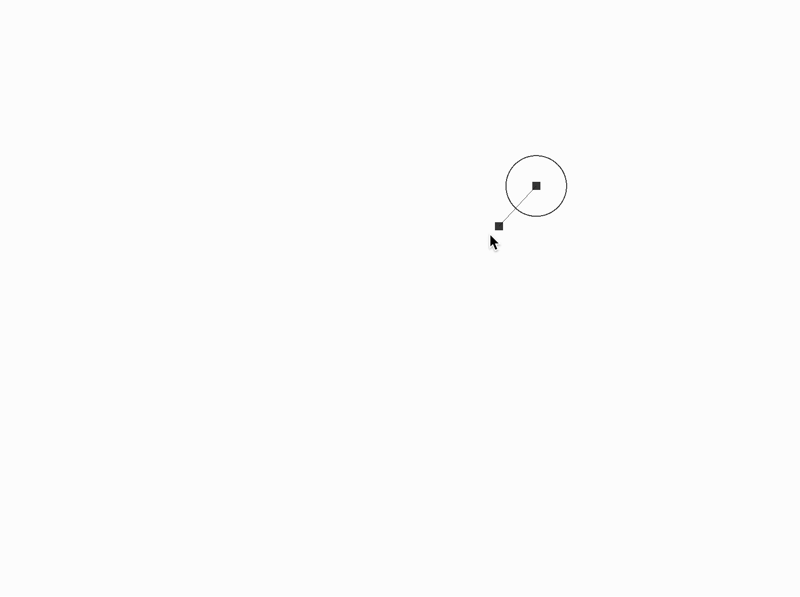
自力で考える
サスペンションのような硬いばねではなくヨーヨーをイメージする。そのヨーヨーは、手の位置に戻ってこようとするが、行きすぎてしまってなかなか手の位置に収まらない。
まずヨーヨーの本体と手の位置を定義する。
yoyo = 1.0
hand = 5.0
ヨーヨーの気持ちになると手の位置に戻りたいのだから 目的地の手 - 自分 で距離がわかる。
hand - yoyo # => 4.0
それを自分に足せば、
yoyo += hand - yoyo # => 5.0
となって手に移動できるので考え方としては間違っていない。間違っているとすれば瞬間移動してしまったところ。そこで距離を少しずつ足していく。
yoyo = 1.0
hand = 5.0
velocity = 0.0
a = 70.times.collect {
yoyo += (hand - yoyo) * 0.2
yoyo.round
}.join
a # => "2233444445555555555555555555555555555555555555555555555555555555555555"
これで徐々に近づくようになった。しかし、ばねだったらぼよんぼよんしてほしい。そこで速度に足すように変更する。
yoyo = 1.0
hand = 5.0
velocity = 0.0
a = 70.times.collect {
velocity += (hand - yoyo) * 0.2
yoyo += velocity
yoyo.round
}.join
a # => "2357899875321123578998753211235789986532112457899865321124679998643111"
これで手の位置を中心にぼよんぼよんするようになった。これで完成でもいいけど、できれば収束させたい。そこで速度に減退率[1]を掛けてみる。
yoyo = 1.0
hand = 5.0
velocity = 0.0
a = 70.times.collect {
velocity += (hand - yoyo) * 0.2
velocity *= 0.93
yoyo += velocity
yoyo.round
}.join
a # => "2356788875433334556777655444445566666555444455566665555445555555555555"
これで手の位置に向けて収束するようになった。このように、専門的なことは置いといて、適当にやってもそれらしい動きになることがわかった。
リファクタリング
ここで、ばね業界について調べてみるとマジックナンバーに名前がついていることがわかった。その他の変数名も含めてリファクタリングした結果、
anchor = 5.0 # 支点の位置
stiffness = 0.2 # ばねの強さ (一言で言えば速度。大きいと速く動く)
damping = 0.93 # 減退率 0..1 (大きいとぼよんぼよんが継続する)
mass = 1.0 # 質量。大きいほど物体は動きにくくなる
location = 1.0 # おもりの位置
velocity = 0.0 # 現在の速度
a = 70.times.collect {
force = (anchor - location) * stiffness
acceleration = force / mass
velocity += acceleration
velocity *= damping
location += velocity
location.round
}.join
a # => "2356788875433334556777655444445566666555444455566665555445555555555555"
となった。名前重要!
どの部分がばねの方程式になっているのか?
フックの法則のばねの方程式は F = -kx と定義されている。コードの (anchor - location) が -x に相当する。ここを間違えて逆に (location - anchor) としてしまうと x になってしまうので注意する。そして残った stiffness が k に相当する。
静止長を考慮する
ばねが伸びても縮んでもいない状態の長さを静止長(rest length)[2]という。静止長を考慮するには支点を目標にするのではなく支点の少し手前を目標にする。その「少し手前」の幅が静止長に該当する。そうすると元のコード
anchor = 5.0 # 支点の位置
location = 1.0 # おもりの位置
stiffness = 0.2 # ばねの強さ
force = anchor - location # => 4.0
force *= stiffness # => 0.8
は、
rest_length = 1.0 # 静止長
gap = anchor - location # => 4.0
stretch = gap.abs - rest_length # => 3.0
force = (gap.positive? ? 1 : -1) * stretch # => 3.0
force *= stiffness # => 0.6000000000000001
となる。このあたりスカラーだと符号の向きを気にかけないといけないので単にベクトルになっていた方が扱いやすい。ベクトルの場合は、
anchor = V[5.0, 0.0] # 支点の位置
location = V[1.0, 0.0] # おもりの位置
stiffness = 0.2 # ばねの強さ
gap = anchor - location # => (4.0, 0.0)
stretch = gap.length - rest_length # => 3.0
force = gap.normalize_or_zero * stretch # => (3.0, 0.0)
force *= stiffness # => (0.6000000000000001, 0.0)
となって簡潔に書ける。
ヨーヨーのように静止長が 0 になる場合は平方根を求める処理が無駄になってしまうので、最適化するなら静止長が 0 かどうかで分岐するのがよさそう。
計算式まとめ
anchor = V[5.0, 0.0] # 支点の位置
stiffness = 0.01 # ばねの強さ (一言で言えば速度。大きいと速く動く)
rest_length = 1.0 # 静止長 (伸びても縮んでもない状態の長さ)
damping = 0.99 # 減退率 0..1 (大きいとぼよんぼよんが継続する)
mass = 1.0 # 質量 (大きいほど物体は動きにくくなる)
location = V[1.0, 0.0] # 物体の位置
velocity = V.zero # 現在の速度
gap = anchor - location # => (4.0, 0.0)
if rest_length == 0
force = gap
else
stretch = gap.length - rest_length # => 3.0
force = gap.normalize_or_zero * stretch # => (3.0, 0.0)
end
force *= stiffness
acceleration = force / mass # => (0.6000000000000001, 0.0)
velocity += acceleration # => (0.6000000000000001, 0.0)
velocity *= damping # => (0.5580000000000002, 0.0)
location += velocity # => (1.5580000000000003, 0.0)
最小限のコード
class App < Base
def initialize
super
@stiffness = 0.02
@damping = 0.98
@location = window_wh * V.rand
@velocity = V.zero
@mass = 1.0
end
def update
super
force = (anchor - @location) * @stiffness
acceleration = force / @mass
@velocity = (@velocity + acceleration) * @damping
@location += @velocity
end
def draw
super
point_draw(anchor)
line_draw(anchor, @location)
point_draw(@location)
circle_draw(@location, 30)
vputs "stiffness: #{@stiffness}"
vputs "damping: #{@damping}"
end
def anchor
mouse_v
end
show
end
パラメータの意味と考え方
いくつかあるパラメータのなかでもっとも影響があるのが「ばねの強さ」と「減退率」で、この調整が難しい。難しい原因は用語にある。「ばねの強さ」「減退率」と言われてもピンとこないからだ。そこで「速度」と「ぼよんぼよんする時間の長さ」と置き換えるとわかりやすい。単に「速度」と「時間」でもよい。
stiffness = 0.01 # ばねの強さ → 速度
damping = 0.99 # 減退率 → ぼよんぼよんする時間の長さ → 時間
また、パラメータの初期値を適当にしてしまうとコードの不具合なのか区別がつかなくなるので初期値は上のようにしたい。
また、なんとなくだが、両方を足して 1.0 になるようにすると、あまり変な動きにはならないことに気づいた。たとえば速度を 0.02 にしたときは、時間を 0.98 にする。なので、調整しすぎてよくわからなくなってきたときには、いったん足して 1.0 を意識する。
密結合を改善する
- ばねの名称は「支点」「ばね」「おもり」に分けられる
- それをそのままオブジェクトと考えて問題ないだろうか?
- 少なくとも「おもり」が「ばね」に依存するのはおかしい
- The Nature of Code では Spring と Bob (おもり) で分離されている
- 一方「支点」は「ばね」の一部だろうか?
- 「支点」は巨大な岩と考えることができる
- であれば「支点」も「ばね」に依存するのはおかしい
したがって「支点」「ばね」「おもり」は別々のオブジェクトになるはず。
そう考えて実装してみたところ、ごちゃごちゃになっていたパラメータが、どのオブジェクトの属性なのか明確になった。たとえば、stiffness や rest_length はばねの属性だが damping はおもりの属性になる。
ただ、数珠繋ぎにする場合など、オブジェクト自身がどこに繋っているかを把握していないと、管理するのが大変になることもわかった。
モデル化したコード
class Spring
def initialize
@stiffness = 0.02
@rest_length = 80.0
end
def connect(a, b)
from_to(a, b)
from_to(b, a)
end
def from_to(from, to)
if from.respond_to?(:acceleration_add)
gap = to.location - from.location
stretch = gap.length - @rest_length
force = (gap.normalize_or_zero * stretch) * @stiffness
from.acceleration_add(force)
end
end
end
class Anchor
def location
$app.mouse_v
end
def draw
$app.point_draw(location)
end
end
class Bob
attr_accessor :location
def initialize
@damping = 0.98
@location = V.rand * $app.window_wh
@velocity = V.zero
@mass = 1.0
@acceleration = V.zero
end
def acceleration_add(force)
@acceleration += force / @mass
end
def update
@velocity += @acceleration
@velocity *= @damping
@location += @velocity
@acceleration *= V.zero
end
def draw
$app.point_draw(@location)
$app.circle_draw(@location, 30)
end
end
class App < Base
def initialize
super
@anchor = Anchor.new
@spring1 = Spring.new
@bob1 = Bob.new
@spring2 = Spring.new
@bob2 = Bob.new
end
def update
super
@spring1.connect(@bob1, @anchor)
@bob1.update
@spring2.connect(@bob2, @bob1)
@bob2.update
end
def draw
super
@bob1.draw
line_draw(@anchor.location, @bob1.location)
@bob2.draw
line_draw(@bob1.location, @bob2.location)
@anchor.draw
end
show
end
連結情報を保持するオブジェクトを用意してみる
ばねの「ばね」部分をラップした Connector クラスを新しく用意し、ばねの両端に接続するオブジェクトを保持するようにしてみた。が、あまりよくなったようには思えない。Nature of Code でもオブジェクト指向の方針に正解はないと書かれていて難しさを感じる。
Connector クラスで連結情報をまとめる
class Connector
attr_accessor :head
attr_accessor :tail
def initialize
@spring = Spring.new
@head = []
@tail = []
end
def update
@head.product(@tail) do |a, b|
@spring.connect(a, b)
end
end
end
class Spring
def initialize
@stiffness = 0.02
@rest_length = 80.0
end
def connect(a, b)
from_to(a, b)
from_to(b, a)
end
def from_to(from, to)
if from.respond_to?(:acceleration_add)
gap = to.location - from.location
stretch = gap.length - @rest_length
force = (gap.normalize_or_zero * stretch) * @stiffness
from.acceleration_add(force)
end
end
end
class Anchor
def location
$app.mouse_v
end
def draw
$app.point_draw(location)
end
end
class Bob
attr_accessor :location
def initialize
@damping = 0.98
@location = V.rand * $app.window_wh
@velocity = V.zero
@mass = 1.0
@acceleration = V.zero
end
def acceleration_add(force)
@acceleration += force / @mass
end
def update
@velocity += @acceleration
@velocity *= @damping
@location += @velocity
@acceleration *= V.zero
end
def draw
$app.point_draw(@location)
$app.circle_draw(@location, 30)
end
end
class App < Base
def initialize
super
@anchor = Anchor.new
@spring1 = Spring.new
@bob1 = Bob.new
@spring2 = Spring.new
@bob2 = Bob.new
@connector1 = Connector.new
@connector1.head << @anchor
@connector1.tail << @bob1
@connector2 = Connector.new
@connector2.head << @bob1
@connector2.tail << @bob2
end
def update
super
@connector1.update
@connector2.update
@bob1.update
@bob2.update
end
def draw
super
@bob1.draw
line_draw(@anchor.location, @bob1.location)
@bob2.draw
line_draw(@bob1.location, @bob2.location)
@anchor.draw
end
show
end
バリエーション
計算方法は同じでも
- パラメータ調整
- ばねの連結
- 支点の有無
などによっていろいろな表現ができる。

ばねというより慣性がわずかに残る移動
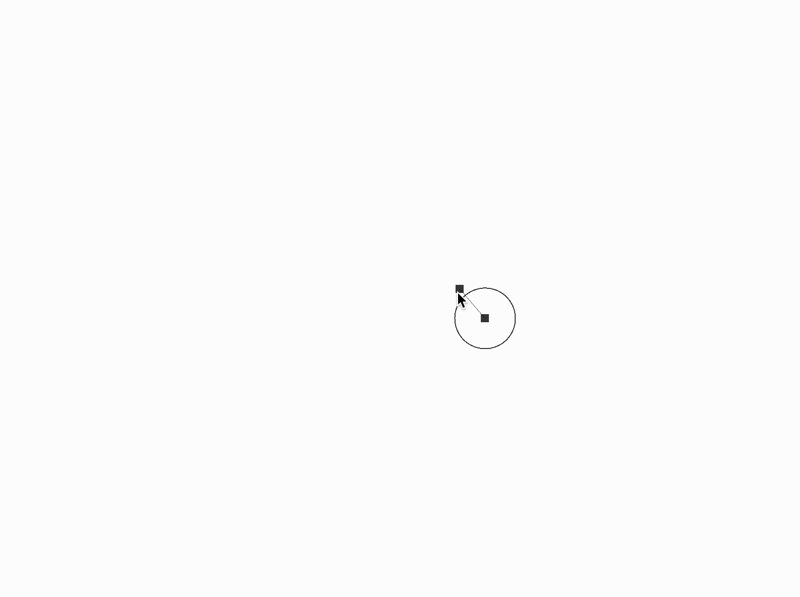
オフストリング系ヨーヨー
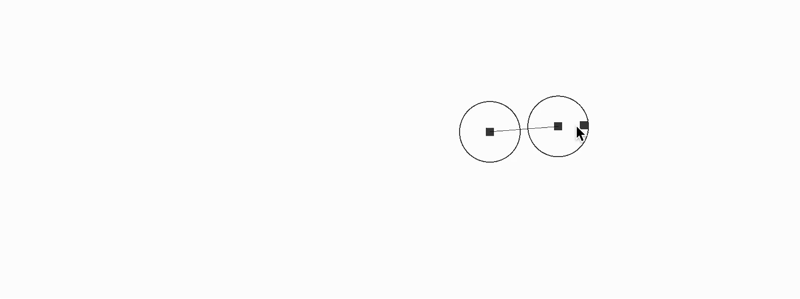
ばねは両端のおもりの影響を受ける
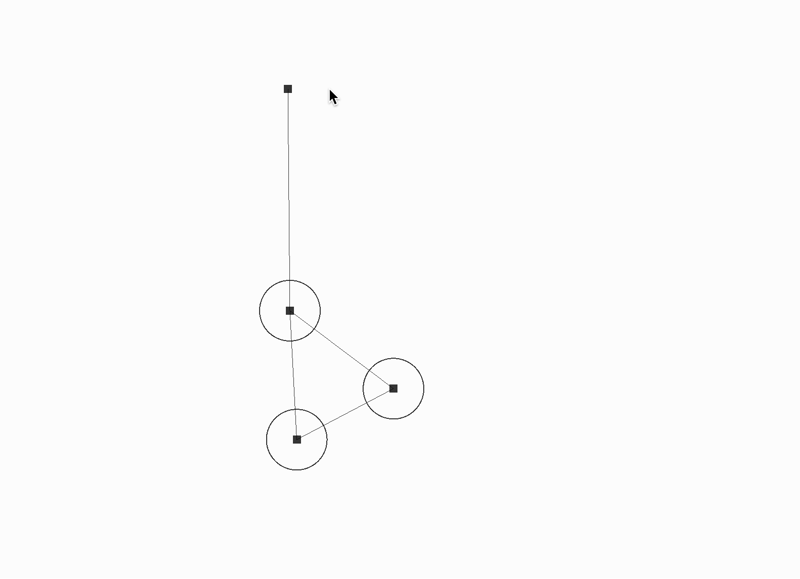
ソロハム(失敗)

謎の生物
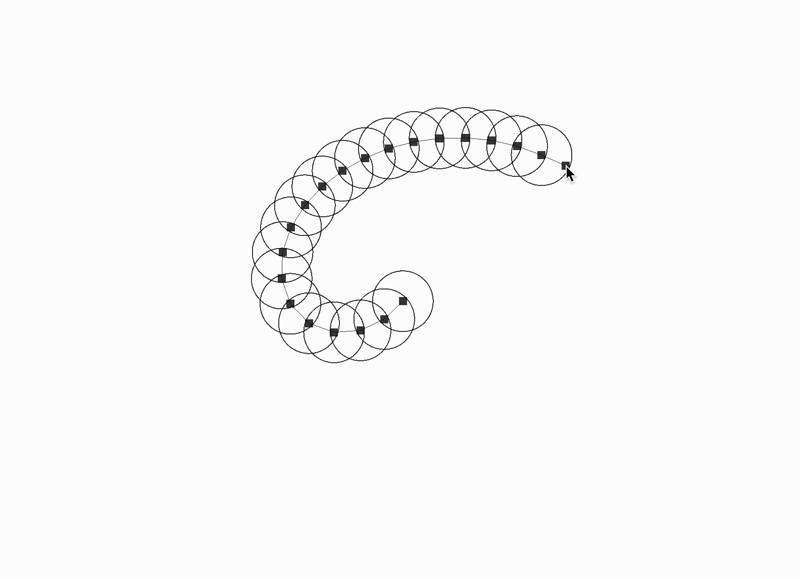
芋虫
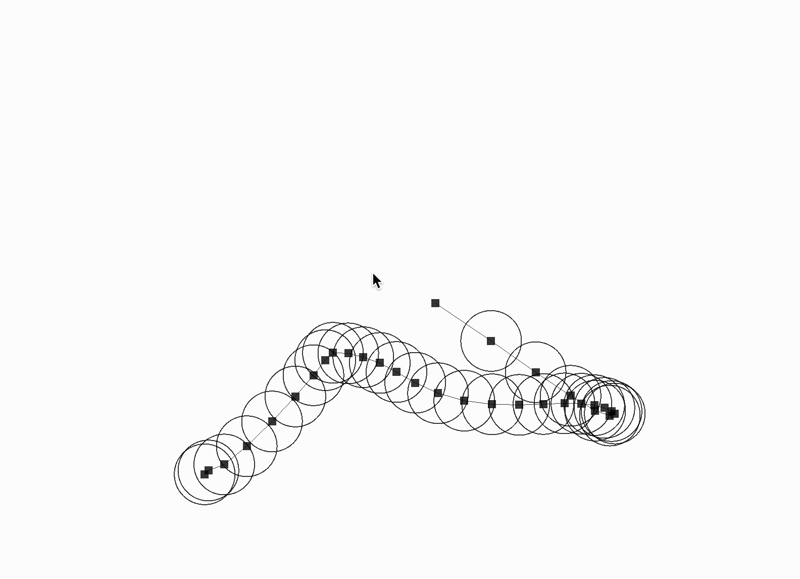
夜店で売ってたばね
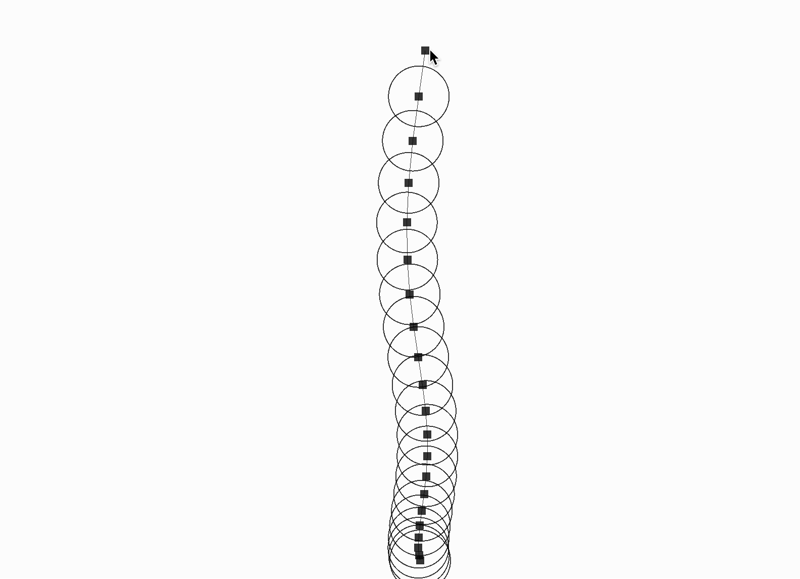
釣ったウナギ
実験用のコード
class Bob
attr_accessor :location
attr_accessor :velocity
attr_accessor :parent
attr_accessor :child
delegate *[
:gravity,
:stiffness,
:damping,
:rest_length,
:mass,
:natural_mode,
:gravity_mode,
:mass_mode,
:chain_mode,
:anchor_mode,
:wind_mode,
], to: "$app"
def initialize(index)
@index = index
@location = $app.window_wh * V.rand
@velocity = V.zero
@acceleration = V.zero
@radius = 30
end
def spring_update
if anchor_mode && @index == 0
spring_apply($app.mouse_v)
end
if chain_mode == 0
# TODO: 重力がかかると子になるにつれて親との距離が半分になっていくるのは自然現象としてあっているのだろうか?
spring_object_apply(parent)
spring_object_apply(child)
end
if chain_mode == 1
spring_object_apply(parent)
end
if chain_mode == 2
spring_object_apply(child)
end
end
def acceleration_add(force)
if mass_mode
@acceleration += force / mass
else
@acceleration += force
end
end
def spring_object_apply(object)
if object
spring_apply(object.location)
end
end
def spring_apply(anchor)
gap = anchor - @location
if natural_mode
stretch = gap.length - rest_length
force = gap.normalize_or_zero * stretch
else
force = gap
end
force *= stiffness
acceleration_add(force)
end
def update
spring_update
if wind_mode
acceleration_add(V.x * 1.0)
end
@velocity += @acceleration
@velocity *= damping
if gravity_mode
@velocity += gravity
end
@location.replace(@location + @velocity)
@acceleration = V.zero
end
def draw
if child
$app.line_draw(@location, child.location)
end
$app.point_draw(@location)
$app.circle_draw(@location, @radius)
if anchor_mode && @index == 0
$app.line_draw($app.mouse_v, @location)
end
if false
if parent
$app.vputs "bob: [#{@index}] #{@location.round(2)} #{(parent.location - location).length}"
end
end
end
end
class ParticleSystem < Array
def update
each(&:update)
end
def draw
each(&:draw)
end
end
class App < Base
attr_accessor :gravity
attr_accessor :stiffness
attr_accessor :damping
attr_accessor :rest_length
attr_accessor :mass
attr_accessor :natural_mode
attr_accessor :gravity_mode
attr_accessor :mass_mode
attr_accessor :chain_mode
attr_accessor :anchor_mode
attr_accessor :wind_mode
attr_accessor :muscle_mode
attr_accessor :ring_mode
def initialize
super
@wind_mode = false
preset1
end
def ps_init
@ps = ParticleSystem.new
ps_add(@bob_count)
end
def ps_add(n = 1)
n.times do
a = @ps.last
b = Bob.new(@ps.count)
if a
a.child = b
b.parent = a
end
@ps.concat([b])
end
@points = @ps.collect(&:location)
ring_mode_update
end
def ps_remove(n = 1)
n.times { @ps.pop }
@points = @ps.collect(&:location)
ring_mode_update
end
def ring_mode_update
unless @ps.empty?
a = @ps.first
b = @ps.last
if @ring_mode
a.parent = b
b.child = a
else
a.parent = nil
b.child = nil
end
end
end
def ring_mode_toggle
@ring_mode ^= true
ring_mode_update
end
# 基本
def preset1
@natural_mode = false
@gravity_mode = false
@anchor_mode = true
@ring_mode = false
@muscle_mode = false
@mass_mode = false
@chain_mode = 0
@bob_count = 1
ps_init
@gravity = V[0.0, 1.0]
@stiffness = 0.02
@damping = 0.96
@mass = 3.0
@rest_length = 100.0
end
# 速い移動
def preset2
preset1
@stiffness = 0.2
@damping = 0.7
end
# ヨーヨー 4A
def preset3
preset1
@gravity_mode = true
@anchor_mode = true
@stiffness = 0.01
@damping = 0.98
@gravity = V[0.0, 0.7]
end
# ヨーヨー 5A
def preset4
preset1
@anchor_mode = false
@natural_mode = true
@ring_mode = false
@muscle_mode = false
@bob_count = 2
ps_init
end
# ソロハム
def preset5
preset1
@anchor_mode = true
@natural_mode = true
@ring_mode = true
@muscle_mode = false
@gravity_mode = true
@stiffness = 0.02
@damping = 0.98
@rest_length = 100.0
@gravity = V[0.0, 0.5]
@bob_count = 3
ps_init
end
# 謎の生物
def preset6
preset1
@anchor_mode = false
@natural_mode = true
@ring_mode = true
@muscle_mode = true
@gravity_mode = false
@stiffness = 0.02
@damping = 0.96
@rest_length = 70.0
@bob_count = 3
ps_init
end
# 芋虫
def preset7
preset1
@natural_mode = true
@gravity_mode = false
@anchor_mode = true
@ring_mode = false
@muscle_mode = false
@stiffness = 0.6
@damping = 0.6
@rest_length = 25.0
@bob_count = 20
ps_init
end
# 夜店で売ってたばね
def preset8
preset1
@natural_mode = true
@gravity_mode = false
@anchor_mode = true
@ring_mode = false
@muscle_mode = false
@stiffness = 0.7
@damping = 0.6
@rest_length = 5.0
@bob_count = 30
ps_init
end
# 釣ったウナギ
def preset9
@natural_mode = true
@gravity_mode = true
@anchor_mode = true
@ring_mode = false
@muscle_mode = false
@stiffness = 0.45
@damping = 0.7
@rest_length = 3.0
@gravity = V[0.0, 0.6]
@bob_count = 20
ps_init
end
def button_down(id)
super
case id
when Gosu::KB_1
preset1
when Gosu::KB_2
preset2
when Gosu::KB_3
preset3
when Gosu::KB_4
preset4
when Gosu::KB_5
preset5
when Gosu::KB_6
preset6
when Gosu::KB_7
preset7
when Gosu::KB_8
preset8
when Gosu::KB_9
preset9
when Gosu::KB_N
@natural_mode ^= true
when Gosu::KB_G
@gravity_mode ^= true
when Gosu::KB_S
@mass_mode ^= true
when Gosu::KB_W
@wind_mode ^= true
when Gosu::KB_M
@muscle_mode ^= true
when Gosu::KB_C
@chain_mode = @chain_mode.next.modulo(3)
when Gosu::KB_R
ring_mode_toggle
when Gosu::KB_A
@anchor_mode ^= true
when Gosu::KB_LEFT, Gosu::KB_RIGHT
@stiffness += (id == Gosu::KB_LEFT ? -1 : 1) * 0.01
when Gosu::KB_UP, Gosu::KB_DOWN
@damping += (id == Gosu::KB_UP ? 1 : -1) * 0.01
@damping = @damping.clamp(0.0..1.0)
when Gosu::KB_J, Gosu::KB_K
@rest_length += (id == Gosu::KB_J ? 1 : -1) * 1.0
when Gosu::KB_H, Gosu::KB_L
@gravity += (id == Gosu::KB_H ? -1 : 1) * 0.1 * V.y
when Gosu::KB_RETURN
@bob_count += 1
ps_add
when Gosu::KB_BACKSPACE
@bob_count += -1
ps_remove
end
end
def draw
super
vputs "[←][→] ばね係数(stiffness): #{@stiffness.round(3)}"
vputs "[↑][↓] 減退度(damping): #{@damping.round(2)}"
vputs "[j][k] rest_length: #{@rest_length.round(2)}"
vputs "[h][l] gravity: #{@gravity.round(2)}"
vputs "[RET][BS] bob_count: #{@bob_count}"
vputs
vputs "[g] gravity #{@gravity_mode}"
vputs "[n] rest_length #{@natural_mode}"
vputs "[s] mass #{@mass} #{@mass_mode}"
vputs "[m] muscle: #{@muscle_mode}"
vputs "[a] anchor_mode: #{@anchor_mode}"
vputs "[r] ring_mode: #{@ring_mode}"
vputs "[w] wind_mode: #{@wind_mode}"
vputs "[c] chain_mode: #{@chain_mode} (experimental)"
vputs
vputs "Preset"
vputs "[1] 基本"
vputs "[2] 速い移動"
vputs "[3] ヨーヨー 1A / 4A (aで離す)"
vputs "[4] ヨーヨー 5A"
vputs "[5] ソロハム"
vputs "[6] 謎の生物"
vputs "[7] 芋虫"
vputs "[8] 夜店で売ってたばね"
vputs "[9] 釣ったウナギ"
vputs
@ps.update
@ps.draw
point_draw(mouse_v)
end
def rest_length
if @muscle_mode
@rest_length * 0.5 + Math.sin((@frame_count / (60.0 * 1.0)).turn_to_rad) * @rest_length * 0.5
else
@rest_length
end
end
def window_size_default
V[1200, 800]
end
def needs_cursor?
false
end
show
end
参照
- https://natureofcode.com/book/chapter-2-forces/
- https://yoppa.org/proga10/1271.html
- https://ja.wikipedia.org/wiki/フックの法則
Discussion